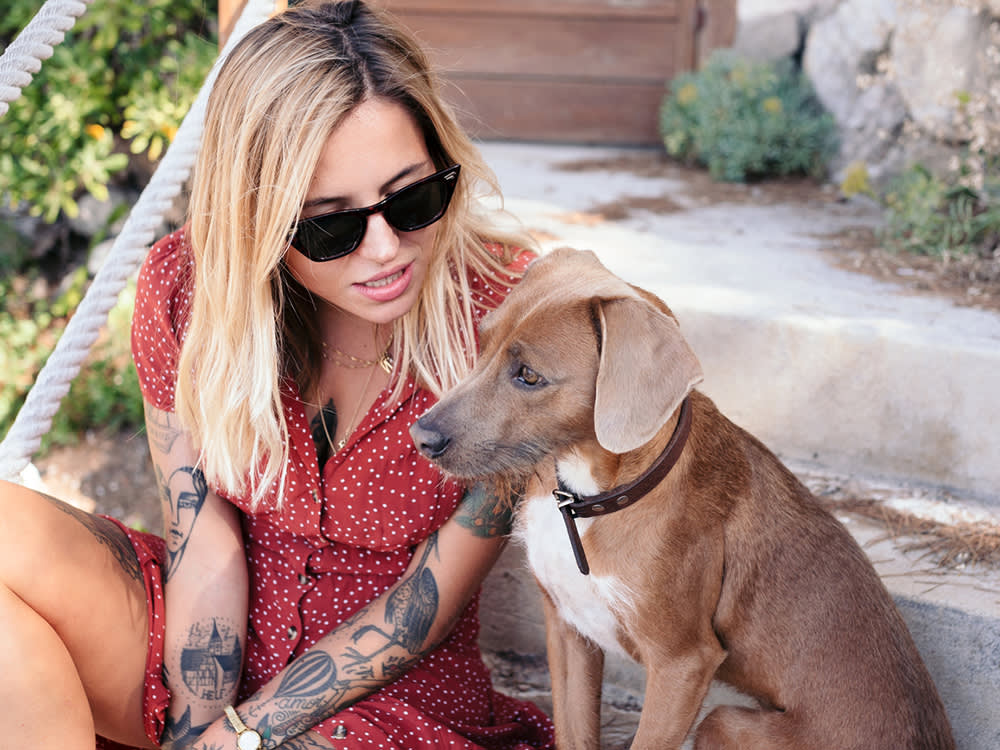Why Do We Want Our Dogs to Talk So Badly?
Tools like speech buttons and translation apps reflect more about our desires for our pets than their desires for themselves.

Share Article
If the algorithms we see reflect the greatest wishes of our hearts and eyes, I can proudly report that approximately 80 percent of my TikTok stream is dogs. Oh, the dogs I see! There are so many dogs, I’ve even noticed that there are a few distinct genres, primarily: clumsy dogs, dogs who have returned home with interesting food they found in a truly unknown location (fresh ears of corn, a wrapped sub sandwich), and dogs sleeping with smushed faces. But, with the algorithm constantly testing my interests, other dog genres sneak in. One that’s always hovering around the edges is: dogs who can talk. Sorta.
First, we must address the pack of adorable — and very TikTok-popular — dogs who use buttons to speak. Developed by speech pathologist Christina Hunger with her dog Stellaopens in new tab, who loves the buttons “outside,” “now,” and “Stella”, dogs across the globe are using these pedals to communicate. Just as a clumsy dog surprised by her own paw will make me laugh, dogs with buttons have not lost their glorious animal spirit. Bunny, another dog is internet famous for using these communication buttons, once got a bath and used her buttons to repeat “now” “I” “mad.”opens in new tab High comedy. But the joke is that Bunny is stating the obvious. Bunny’s posture, expression, movements are already saying “now” “I” “mad.” No buttons needed, really.
Dog communication gadgets of this sort have existed for a long timeopens in new tab, but the new and explosive popularity of these buttons, or at least the popularity of the dogs who use them, indicates humans clearly have a fierce intention to verbalize what our pets are trying to tell us. We go to extravagant, sci-fi level lengths to try to figure this out. A mat of buttons with the words “ball” “help” “treat” will not satisfy our curiosity. There are frequently new apps in developmentopens in new tab that promise to translate a dog’s barks into a language humans can understand.opens in new tab At the University of Glasgow’s School of Computing Science, Dr. Ilvena Hirskyj-Douglas is continuing to develop a “DogPhone” that lets pets call their owners when they’re away and speak to them.
Of course, I too have been flummoxed about the enigma of what my dog is trying to tell me. He’ll stare at me with telekinetic intensity, his yellow-gold eyes latched onto mine. Does he want to go out? Does he want an unwarranted second dinner? Does he want my spot on the couch? Does he want his rope toy that I’ve cruelly taken away so he doesn’t ingest loose threads? None of the above? But even if it’s something specific he’s trying to say, what I know he wants is for me to pay attention to his communication.

Of course, it would be wonderful to know his secrets. Sometimes, when he’s listless, I wonder if there was an “ouch” button like the famous Bunny has, would he tell me if this was secretly a stomachache. That seems very useful and worthwhile as an emergency measure! He also seems, at least, to be able to communicate through movement, posture, whining, and behavior — for example licking his sore paw or wiggling away from a behind-the-ear scratch — if there’s an “ouch” for me to know about.
In the years I’ve gotten to know him (he was my partner’s dog first, but I became the official step-dad when he was about two) we’ve gotten so much better at communicating and paying attention to each other. It’s taught me to be a better nonverbal communicator, in general, I think. And I know this is the position of a dreary, boringgggg luddite, but I wonder if that layer of communication would be lost by the buttons and the translator and the dog phone.
These attempts to bridge communication aren’t necessarily transmitting the dog’s deepest thoughts and feelings, they’re just the dog’s missives to you. Similarly, when we reach out our hands to our dogs for a paw, this movement doesn’t capture our innermost spirits, or even everything we’d like to communicate to our pet. It’s just a form of engagement through gesture. Getting contraptions involved can potentially clarify, they can certainly be funny, but also they seem to outline a void that might not be there if we weren’t insistent on requiring verbalization from our pets.
In general, all these tools, of course, reflect so much more about our desires for our pets than their desires for themselves. Really, why are we insisting on bringing them into our level, when human communication is historically so flawed and not cool? And dog communication (seemingly) involves patient attentiveness, deep intuition, and forgiving affections? Who should aspire to communicate like whom, huh?

Maggie Lange
Maggie Lange is a writer, editor, and columnist. Her work has been featured in New York Magazine, Vice, Guernica, GQ, Rolling Stone, Pitchfork, Elle, and Bon Appetit. She lives in Philadelphia with her favorite brindle boy, Finn.
Related articles
![]()
What Are Dog Communication Buttons? And How to Use Them
Cognitive Science professor Dr. Federico Rossano on how Bunny, TikTok’s “talking” dog, is sparking change in how we communicate with our pets.
![Young woman sitting at desk petting her senior Great Dane]()
How to Speak “Dog”
Lili Chin’s book Doggie Language illustrates how dogs communicate — beyond ear perks and tail wags.
![Brown puppy on grey couch watching a smart phone]()
New Phone, Who Dis?
Researchers at the University of Glasgow are testing a “DogPhone” that allows your pet to video-call you. We gave its architect, Dr. Ilyena Hirskyj-Douglas, a ring to hear more.
![Woman sitting with her dog outdoors]()
How to Talk to Your Dog, According to Science
Baby talk works on puppies. As for adult dogs, that’s still up for debate.




